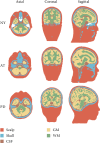Influence of Patient-Specific Head Modeling on EEG Source Imaging
- PMID: 32328152
- PMCID: PMC7157795
- DOI: 10.1155/2020/5076865
Influence of Patient-Specific Head Modeling on EEG Source Imaging
Abstract
Electromagnetic source imaging (ESI) techniques have become one of the most common alternatives for understanding cognitive processes in the human brain and for guiding possible therapies for neurological diseases. However, ESI accuracy strongly depends on the forward model capabilities to accurately describe the subject's head anatomy from the available structural data. Attempting to improve the ESI performance, we enhance the brain structure model within the individual-defined forward problem formulation, combining the head geometry complexity of the modeled tissue compartments and the prior knowledge of the brain tissue morphology. We validate the proposed methodology using 25 subjects, from which a set of magnetic-resonance imaging scans is acquired, extracting the anatomical priors and an electroencephalography signal set needed for validating the ESI scenarios. Obtained results confirm that incorporating patient-specific head models enhances the performed accuracy and improves the localization of focal and deep sources.
Copyright © 2020 Yohan Céspedes-Villar et al.
Conflict of interest statement
The authors declare that there are no conflicts of interest regarding the publication of this paper.
Figures









References
Publication types
MeSH terms
LinkOut - more resources
Full Text Sources

